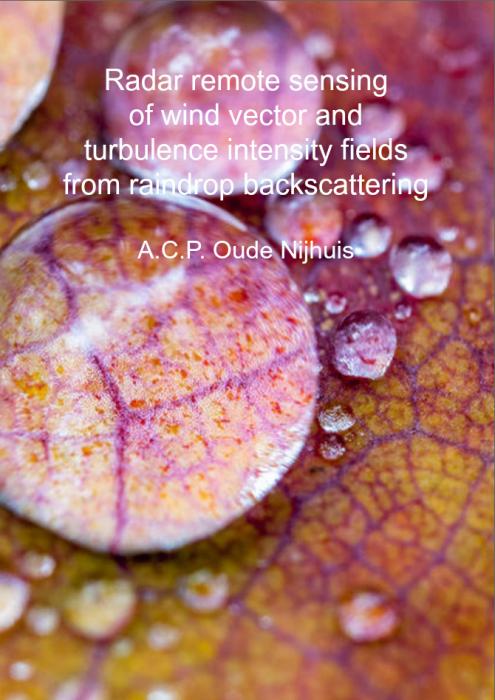Agenda
PhD Defence
- Wednesday, 16 January 2019
- 14:45-16:00
- Aula- Senaatszaal
Radar remote sensing of wind vector and turbulence intensity fields from raindrop backscattering
Albert Oude Nijhuis
Nowadays, well-validated (experimentally and theoretically) formulas exist for the raindrop terminal fall velocity, based on a balance between the forces acting on a raindrop. In Chapter 2 the next step is taken, and raindrop inertial parameters are derived by considering an imbalance of forces acting on a raindrop. Based on the `sudden jump' case, inertial distance and inertial time parameters are derived for each raindrop size, with different formulations for the x/y-direction and the z-direction. These parameters are essential for the development of models and retrieval techniques that take the influence of measuring from imperfect air tracers (read: raindrops) into account. A new raindrop inertia correction model was proposed that can easily be integrated into existing turbulence models and retrieval techniques as an extra factor. From simulations, it was derived that for large radar total sampling scales ( 30 m), the influence of raindrop inertia on retrieved turbulence intensities becomes negligible. For radar total sampling scales comparable to or smaller than 30 m, the raindrop inertia correction model was suggested. For small radar total sampling scales ( 10 m) and large raindrops (e.g. 4 mm), the application of the proposed correction model becomes limited, because the uncertainty in the retrieved turbulence intensity becomes very large as a result of the influence of raindrop inertia. In Chapter 3, state-of-the-art and commonly-used turbulence intensity retrieval techniques are assessed, when they are applied to raindrop-backscattering radar Doppler measurements. The inertia correction model was not used here for two reasons: (1) it is assumed that often a good estimation of the drop size distribution (DSD) is not available; and (2) it can be expected that the influence of inertia is negligible when a large total sampling scale is used. The quality of retrieved values for the energy dissipation rate (EDR) was optimized, based on comparisons with in situ measurements from a sonic anemometer. As a result, the most optimal technique is the wind speed variance (WSV) EDR retrieval technique, which uses the full 3D wind vector from a profiling radar, TARA. Other turbulence intensity retrieval techniques, which rely on terminal fall velocity corrections, and thus depend on accurate estimation of the DSD, are compromised by errors in the estimated turbulence spectral width. For further applications, it is recommended that the concept of EDR is applied cautiously, because of complex estimation errors. It is suggested to always estimate a minimal retrievable EDR, give uncertainty estimates for the retrieved EDR value, and provide the sampling and total sampling scales that were used in the EDR retrieval technique. In Chapter 4 the focus is on radar-based retrieved wind vectors. From a few simulations of raindrop motions in predefined wind fields, it was concluded that only for very special weather conditions a substantial influence of raindrop inertia on the retrieved wind vectors can be expected. As this work is not aimed at such special weather conditions, the influence of raindrop inertia is not accounted for in wind vector retrieval techniques that are proposed and studied in this work. A new wind vector retrieval technique was developed and implemented, which is the four-dimensional variational analysis (4D-Var) wind vector retrieval technique, which provides a more coherent and realistic wind field in comparison to other existing techniques. With the 4D-Var wind vector retrieval technique, it is also possible to show the solution space of wind vectors, which are associated with measurements from a single scanning Doppler radar. In the case of insufficient or no in situ wind vector measurements for validation, an alternative approach for quantitative validation of radar-based retrieved wind vectors is desired. Therefore, measures for curl and divergence of the wind vector field are used to qualify and optimize the retrieved wind vectors. By selecting the right settings for a wind vector retrieval technique, retrieval of spurious wind vectors can be prevented, which are related to the implementation and configuration of an algorithm. In Chapter 5, the application of raindrop-backscattering radar-based turbulence intensity retrieval techniques to small sampling scales is studied in detail. With ``small sampling scales'' the radar resolution volume scale of modern research weather radars is meant, which has a typical spatial scale of 30 m. A non-stochastic turbulence implementation to model radar observables is developed, the so-called ``ensemble of isotropic vectors'' approach, which can be used in radar-based turbulence intensity retrieval techniques. The goal for this turbulence implementation is to get the same turbulence-intensity dependencies in the polarimetric radar observables as for stochastic turbulence implementations. A novelty of this ``ensemble of isotropic vectors’' approach is that it implicitly reproduces the canting angle distribution of raindrops, on which so many polarimetric radar observables depend. The performance of the proposed technique is demonstrated in a case study. It was not possible to use radar-based estimations of the DSD in this case study at small sampling scales, because several state-of-the-art radar-based DSD estimations overestimated the Doppler spectral width due to raindrop terminal fall velocities. Therefore, in situ ground-level DSD measurements have been used in this case study. With the ground-level DSD information, the application of the raindrop inertia correction model is demonstrated for radar-based turbulence intensity retrieval techniques applied to the small sampling scales of modern research weather radars during the rain. In Chapter 6, the application of raindrop-backscattering radar-based retrieval techniques is demonstrated at an airport. This was done within the UFO project and can be used in the future to reduce wind hazards at airports. The 4D-Var wind vector retrieval technique is recommended, as it has several advanced processing features. In particular, this technique gives more control and versatility in the solutions. For turbulence intensity retrieval techniques applied at airports, it is recommended to avoid corrections for raindrop inertia, which relies on accurate estimation of the DSD.
Additional information ...